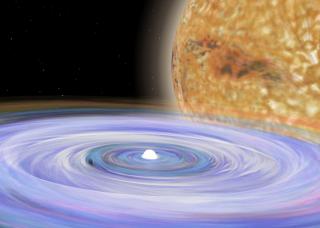Bibcode
Hernández, M. S.; Tovmassian, G.; Zharikov, S.; Gänsicke, B. T.; Steeghs, D.; Aungwerojwit, A.; Rodríguez-Gil, P.
Referencia bibliográfica
Monthly Notices of the Royal Astronomical Society
Fecha de publicación:
5
2021
Número de citas
7
Número de citas referidas
7
Descripción
We analyse a wealth of optical spectroscopic and photometric observations of the bright (V = 11.9) cataclysmic variable BG Tri. The Gaia DR2 parallax gives a distance d = 334(8) pc to the source, making the object one of the intrinsically brightest nova-like variables seen under a low orbital inclination angle. Time-resolved spectroscopic observations revealed an orbital period of $P_{\rm {orb}}=3.8028(24)$ h. Its spectroscopic characteristics resemble RW Sex and similar nova-like variables. We disentangled the H α emission line into two components, and show that one component forms on the irradiated face of the secondary star. We suggest that the other one originates at a disc outflow area adjacent to the L3 point.
Proyectos relacionados

Estrellas Binarias
El estudio de las estrellas binarias es una parte esencial de la astrofísica estelar. Una gran parte de las estrellas de nuestra Galaxia y de otras galaxias se ha formado en sistemas binarios o múltiples, por lo que entender la estructura y evolución de estos sistemas es importante desde el punto de vista estelar y galáctico. Un aspecto en el que
Pablo
Rodríguez Gil